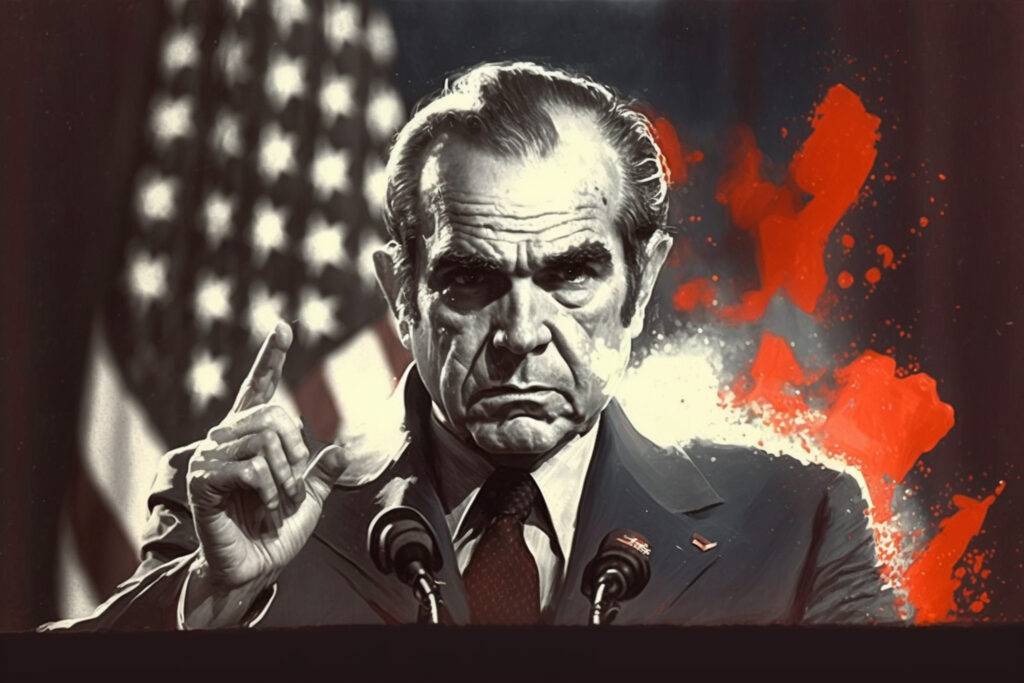
The Bretton Woods system, which came into effect in 1944, was a landmark agreement that established the rules for international monetary and financial relations. It was based on the US dollar’s convertibility into gold at a fixed rate of $35 per ounce, with other currencies pegged to the dollar.1 The system worked well for a while, but by the late 1960s, the US was under increasing strain due to mounting trade deficits and the growing supply of dollars in circulation.2
On August 15, 1971, US President Richard Nixon announced a series of measures that would end the convertibility of the dollar into gold, marking the end of the Bretton Woods System. This event, which became known as the Nixon Shock, had far-reaching consequences for the global economy and the international monetary system.2
Money, Power and Incentives

Before we get into the exact events that led to this scenario, let’s discuss the position the US was in. It held the gold of many countries including those of its allies such as France, the UK and Germany. Using a fractional reserve system meant that as long as not everyone at once tried to claim back the gold, the US could continue printing dollars without the risk of defaulting on its gold obligations. For this to work, confidence in the dollar was paramount.
The events that led up to the Nixon shock are many. It was in part due to the newfound power the US had been gifted and in part to the new enemies WWII created. After the end of the war, there began a new slow and insidious war, the Cold War. The cloak-and-dagger struggle for power between the US and Russia was so strategically and politically important that it lingers on to this day through proxy wars around the world. Given what was at stake, It was fear rather than reason that led to the financial policy during this period, even if that meant deception in order to obtain it.3 The link between war and the creation of dollars had never been stronger, and the US held all the cards.
Guns & Butter

The late 1960s were a tumultuous time for the United States. The country was engaged in the Vietnam War displaying their commitment to the Truman Doctrine, established in 1947 that stated the US would provide military and economic assistance to countries threatened by communism.4 For the United States, the cost of the war was immense. To put it into perfective, the government spent the equivalent of 1 trillion of today’s dollars on the war effort, which led to a significant increase in government debt and inflation.5
At the same time, the government was implementing The Great Society programs, which aimed to reduce poverty and inequality in the country. These programs required significant funding, which the government financed through deficit spending.6
In traditional finance, the guns and butter curve refers to the economic relationship of military spending vs social spending as a percentage of total GDP. Often countries would have to sacrifice one for the other. However, during this period in American history, the US was spending on both.6
The combination of the Vietnam War and the Great Society programs led to a significant increase in government spending and a corresponding increase in the budget deficit. This deficit was financed through the issuance of US Treasury bonds (issuing debt in order to create money), which were bought by foreign governments and investors. As a result, there was a significant increase in the supply of US dollars in circulation.6
The Financial Unwind

The financial status of the United States began to unravel in the late 1950s and early 1960s when they required funding for military campaigns. They drew on their gold stores to fund the Korean War, and after the war, the US was no longer a creditor nation as they no longer held enough gold stock to pay outstanding dollar balances. This was the first sign of a weakening system. The US looked to the IMF and World Bank, who were subordinates to the US, to maintain the USD reserve status. As confidence in the dollar fell, nations began selling dollars in exchange for gold. This in turn raised the exchange rate of gold relative to the dollar, further signalling the weakening of the dollar. As the faith in the dollar spiralled, the US began to fear the equivalent of an international bank run on their diminishing gold reserves.7
In 1961, the US attempted to create the London gold pool, a price-fixing scheme where the Europeans and Americans agreed to dump gold onto the market whenever the price moved above 35 dollars/ounce. At the time, the two biggest gold producers, the Soviet Union and South Africa, were enemies of the US and had to sell gold to finance their economies since they could not get a loan from the Allies. This tactic lasted for 6-7 years but eventually failed. France left the gold pool in 1967 eventually leading to its collapse in 1968.2,7
The IMF and the US then agreed to have an inter-governmental price for gold fixed at 35 dollars/ounce and a separate market price for everyone else. The market price eventually surpassed 200 dollars/ounce, as gold found its true market value. The allies’ efforts to suppress the price of gold to make their paper gold system more attractive were failing. The last-ditch effort was the creation of the SDR, another form of paper gold. However, at this stage, many nations began to realise that it was unlikely they would be able to redeem their paper IOU for any gold at all.2,7
The Triffin Dilemma

The Triffin Dilemma, first postulated by Robert Triffin in the 1960s, states that if a nation’s currency is used as the world’s reserve currency, it becomes impossible for that nation to maintain a surplus. This is because there is an artificial demand for the currency, and in order to meet that demand, the nation must run a deficit. However, running a deficit makes it impossible to maintain the reserves needed to back the currency.8
This dilemma proved to be true as other nations questioned the strength of the US dollar and called America’s bluff. The US was unable to maintain its gold reserves as Triffin hypothesised. In 1971, President Nixon announced that the US would temporarily stop the convertibility of US dollars for gold. It is now over 50 years since that temporary policy was instated. Dollars are no longer redeemable for gold at 35 USD per ounce for any nation. The USD was no longer tethered to gold and all other currencies linked to the USD went into free fall.2,8
The official announcement did not offer apologies. Instead, Nixon stated that “speculators” were intentionally selling the dollar to buy gold as a way to attack the US. He also dismissed that the government had devalued the dollar and had not caused inflation, rhetoric that is still present in today’s politics.
The US had effectively defaulted on billions of dollars worth of gold, including gold obligations to many allied nations such as France, the UK and Germany.7 Under normal circumstances, countries would object and threaten war if an agreement could not be reached. By this stage, however, the US had amassed so much military strength that challenging them would likely be detrimental to their already declining financial situation. On top of that, they voluntarily held dollar balances because of their valuable service flow from a global network that had already been well established. A political win for the US and a financial loss for the rest of the world. It was possibly one of the greatest heists of our time. The world had been robbed by the very money and power it had handed over to the US at Bretton Woods.
References
- Bretton Woods system. Wikipedia. Available at: https://en.wikipedia.org/wiki/Bretton_Woods_system.
- Nixon Shock. Wikipedia. Available at: https://en.wikipedia.org/wiki/Nixon_shock
- Higgs, R. (1988). U.S. Military Spending in the Cold War Era: Opportunity Costs, Foreign Crises, and Domestic Constraints. Cato Institute Policy Analysis
- Khan Academy. Start of the Cold War (Part 2). Available at: https://www.khanacademy.org/humanities/us-history/postwarera/postwar-era/a/start-of-the-cold-war-part-2
- Kelly R. The Balance. (2022). Vietnam War Facts, Definition, Costs, and Timeline. Retrieved from https://www.thebalance.com/vietnam-war-facts-definition-costs-and-timeline-4154921
- Helsing JW. Johnson’s War/Johnson’s Great Society: the guns and butter trap. Westport, Conn: Praeger Greenwood; 2000
- Gladstein, A. The Hidden Costs of the Petrodollar. Bitcoin Magazine. Available at: https://bitcoinmagazine.com/culture/the-hidden-costs-of-the-petrodollar
- Triffin dilemma. Wikipedia. Available at: https://en.wikipedia.org/wiki/Triffin_dilemma.
These articles were designed to make these concepts more palatable. If you’re interested in reading a more in-depth perspective on the transition to fiat currency, consider the following:
ENDEVR. “End of the Road: How Money Became Worthless.” Youtube documentary, https://www.youtube.com/watch?v=NJd6RKsY5H4
Saifedean Ammous, “The Bitcoin Standard: A Decentralised Alternative to Central Banking”. Wiley, 2018
Saifedean Ammous, “The Fiat Standard: The Debt Slavey Alternative to Human Civilization”. Wiley, 2021
Investopedia. “How Petrodollars effect the US dollar.” https://www.investopedia.com/articles/forex/072915/how-petrodollars-affect-us-dollar.asp
Gladstein, Alex. “Uncovering the hidden costs of the Petrodollar.” Bitcoin Magazine, https://bitcoinmagazine.com/culture/the-hidden-costs-of-the-petrodollar

Ruki is a passionate Bitcoin educator who firmly believes in the principles of the Austrian School of Economics. As a sound money advocate he recognises its benefits to individuals and society as a whole. He is dedicated to empowering those without financial access to take control and build a more secure future.
